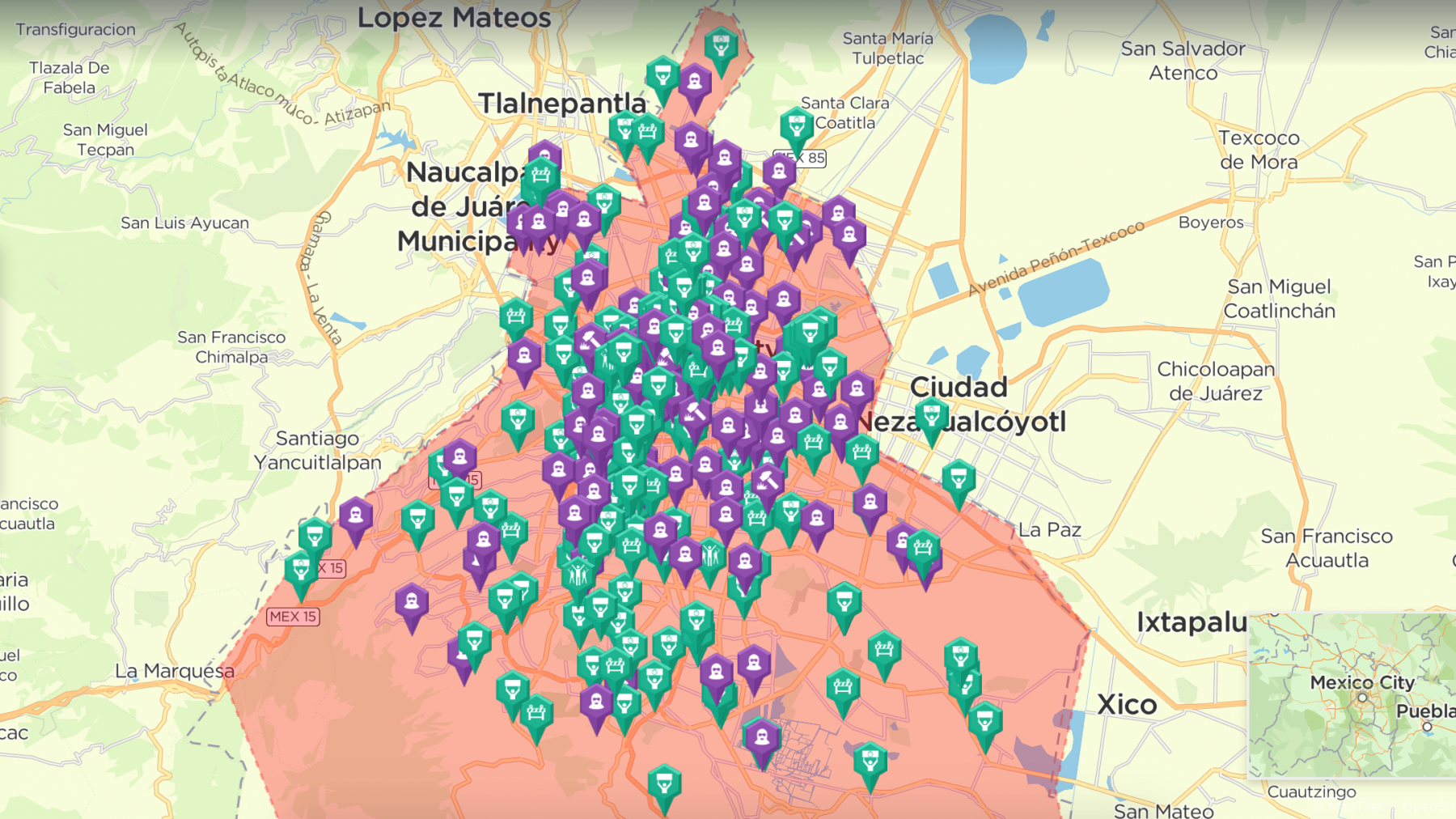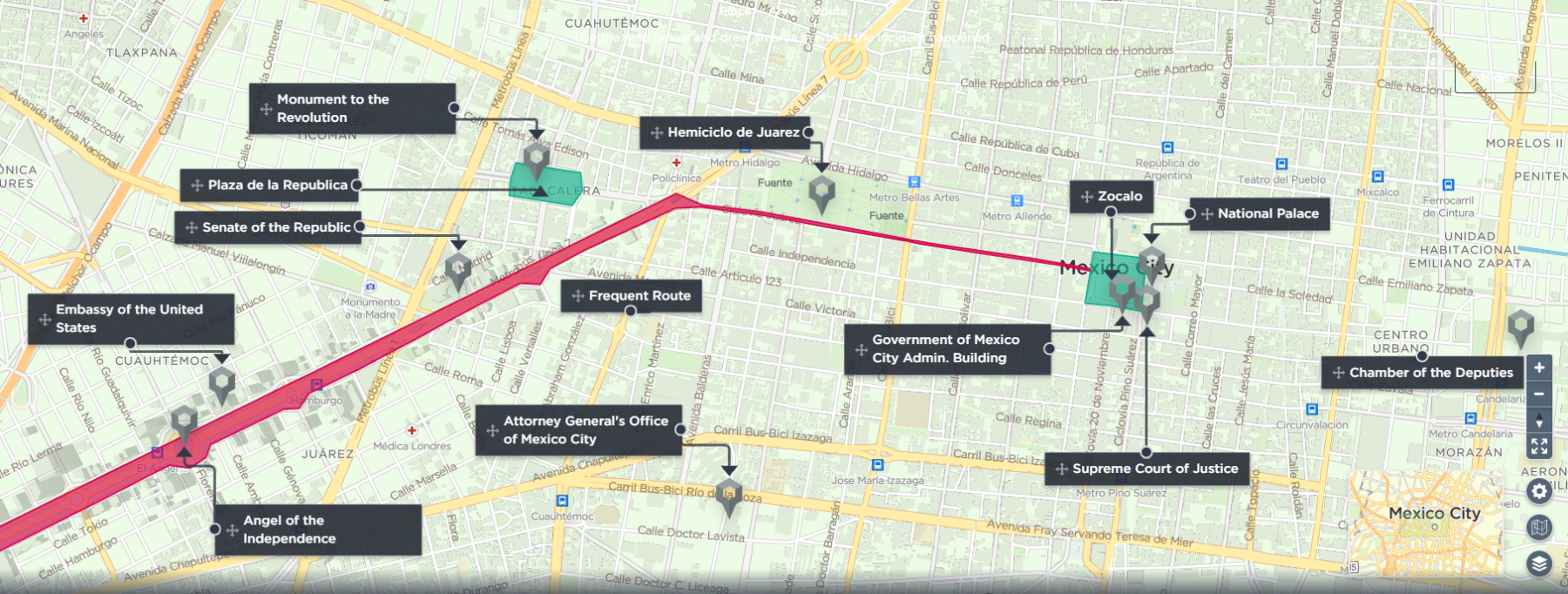The effects of protests on businesses in Mexico City
As the political and economic hub of Mexico, Mexico City is of importance for both national and international businesses, and in turn sees a large number of business travellers every year. While crime is of significant importance in the country, which ranks as one of the most violent in the world, protests can be just as disruptive to travellers and business operations.
Mexico City is divided into 16 boroughs, of which the population is greater than 8.85 million people. The greater metropolitan area of Mexico City sees the population climb to over 21 million people. While the city generates a large percentage of the Mexican GDP, the city and the country still see large amounts of economic inequality, leading to issues of insecurity. This insecurity has led to a number of protests from those targeted by it, such as women. As the political hub of the country, most protests demanding changes in policies, from demanding greater security to legalising marijuana, often take place in Mexico City, with certain areas of the city seeing the greatest influx of activity.
As the economic hub of the country, a number businesses and workers’ unions have headquarters in the city. Protests have been reported at both, as well as in front of government buildings, in order to express their desire for change from increases in salary, to improved working conditions, to demanding that companies abide by collective bargaining agreements. With protests having the potential to be highly disruptive to business travellers and businesses’ static sites, we took a closer look at the protests over the last year to get a clearer picture of when and where protests take place, who takes part, and how a threat intelligence platform can help businesses better protect their people, assets and reputation amidst disruption.

Using the geofence tool to highlight the locations of demonstrations, planned demonstrations, riots, roadblocks, vandalism and thefts in Mexico City over the course of 2020. Accurate as of the 22nd November 2020. [Source: Intelligence Fusion]
Why do people protest in Mexico City?
Protests are a daily occurrence in Mexico City, with groups protesting for a variety of reasons. With 2020 being dominated by the COVID-19 pandemic, a number of protests have been in regard to the response, or lack of, from the government of President Andres Manuel Lopez Obrador. The National anti-Andres Manuel Lopez Obrador Front (FRENA) have been at the forefront of this movement and have installed encampments in several parts of the city, including Av. Juarez and the Zocalo. Healthcare workers protested early on in the pandemic at hospitals across Mexico City to demand adequate personal protective equipment, while in recent months, the protests have been more focused on the economic aspects of the pandemic. Groups such as employees at airlines or airports, as well as street vendors and artists among others, have all protested to demand support in order to get through the economic impacts of COVID-19.
More broadly, other economic based protests have included employees of certain unions to demand that agreements signed with the Federal Government be respected, unions and other groups protesting against budget cuts, as well as groups demanding the protection of wages and demanding employment for those in the working class. Groups who have taken part in such protests include the National Coordinator for Education Workers (CNTE), the Mexican Electricians Union (SME), and the National Torch Movement among others. Other economic protests have included taxi drivers demanding the government take action to protect them from unfair competition by app-based taxi drivers from platforms like Uber and Cabify, or employees of companies protesting to demand the payment of their salaries and/or their benefits, which may have not been paid for several months.
Most other protests in the city have been in regard to societal and security issues. Protests in regard to the legalisation of marijuana or to call for the legalisation of abortion have been common, while calls for justice for victims of violence or who have disappeared in acts of police brutality or due to cartel activity have also been brought to the forefront in the capital. Feminist groups have been particularly active in recent years, not only pushing for the legalisation of abortion, but calling for an end to gender-based violence and addressing the culture of ‘machismo’ in Mexico. Femicides and acts of sexual harassment have been on the rise in Mexico, with acts of sexual harassment common in the metro system of Mexico City.
Where is most impacted by protests in Mexico City?
Protests in Mexico City have taken place in all the boroughs of the city, but the majority have been concentrated in the central neighbourhoods, where local and federal government administrative buildings, along with union and business headquarters are located. The Mexico City metro system is the second largest in North America and provides ease of movement and access for protesters looking to protest at certain locations.

Looking at historical incidents for 2020, there are certain locations where protests are most common in Mexico City, including the Zocalo, also known as Plaza de la Constitucion, as well as the Plaza de la Republica. These are two areas with easy access and where large groups of people can gather. The Plaza de la Republica has often seen static protests or has seen the agglomeration of protesters prior to marching or conducting a caravan to the Zocalo. The Zocalo has often seen static protests, while often being the end point of marches or caravans from across the metropolitan area, in part because of being surrounded by government buildings such as the National Palace.
We consider a protest as ‘static’ when the majority of it is spent at a single location. These protests include gatherings and rallies at parks or outside buildings. Protests are considered ‘dynamic’ when they involve a number of moving parts and are not tied to a singular location. These protests may include ‘static’ events such as gathering at a park or building, but only temporarily. These ‘dynamic’ protests include marches and drive-by protests, as well as any riots that may involve running street clashes with police at multiple locations.
Do protests turn violent?
Protests for the most part remain peaceful, even if they may cause traffic disruption if protesters decide to block a road intersection or conduct a march. Recent protests that have seen elements of violence have been recent feminist protests, and protests in June 2020 against police violence. Violence, including targeted attacks on the police or vandalism on businesses, have often been blamed on a minority of agitators, including anti-fascist groups, who trail the main protest group in order to be able to use the crowd to lose themselves after committing their activities.
Recent feminist protests against gender-based violence saw small groups of anarchist feminists clash with the police using hammers and pickaxes, as well as vandalising the Mexico City Attorney General’s Offices, throwing documents outside and setting them on fire. In October, feminist anarchists also vandalised several police vehicles during a protest. The spray painting of buildings and monuments were also commonplace. In September, during a large feminist march to demand the legalisation of abortion, clashes with police were also reported, with Molotov cocktails being thrown at officers. Some of the more recent protests in Mexico City by feminists were motivated by police repression of a feminist protest in Cancun, State of Quintana Roo, showing the impact that events across Mexico can have on activity in the capital. Dates such as the International Women’s Day on the 8th March or the International Day for the Elimination of Violence Against Women on the 25th November are often accompanied by large scale protests which may devolve into vandalism.
While vandalism has targeted transport links, from bus stations to metro stations, during the most recent protests, businesses have also been targeted. Large scale protests broke out in early June in Mexico City in response to the killing of a man in the State of Jalisco by Municipal Police officers. The protests also made mention of George Floyd, an African American man who was killed by a police officer days before in Minneapolis in the United States. Protests in Mexico City saw large scale activity along Av. Paseo de la Reforma, as well as on Av. Juarez and 5 de Mayo streets towards the Zocalo. Vandalism and rioting were also reported in the Polanco neighbourhood. Businesses along these main streets and areas, along with several side streets, were impacted by vandalism and looting. Several banks, bus stops, convenience stores, as well as the Adidas store on 5 de Mayo street were targeted. The damage caused during the several days of protesting led to tens of thousands of dollars in damages, as well as lost time for businesses.
We analysed 330 protests actions between October and November 2020 and found that most protests start sometime between 9AM and 12PM. Protests starting later in the evening or at night are uncommon. The largest percentage of the protests is for protests that have no given start time but are said to be planned to take place throughout the day.
What can we expect to see in the near future?
Mexico City will continue to be the site of protests due to its importance as the political and economic hub as the capital city of Mexico. For businesses operating in the city, or who may have employees travelling to the city for any period of time, understanding when and where protests take place are key to mitigating the risks that may be faced. By analysing the protests that have taken place in the city in 2020, it was seen that the 48% of protests started between 9AM and 12PM, with another 17% of protests said to have no specific start time, but to take place during the day. Protests are primarily static (79%) but can still cause significant disruptions due to road blockages. The average time a protest lasts is not clear, but disruptions can be from minutes to several hours.
Protests are likely to continue to primarily affect the main roads and areas in central Mexico City, where a significant number of government buildings and monuments are located. These roads include Av. Paseo de la Reforma, Av. Juarez, 5 de Mayo St., and Av. Insurgentes, while also including the Zocalo and Plaza de la Republica as areas that may see the gathering of protesters. The continued focus on these roads and areas by protesters will have significant impacts for business operations and business travellers, both Mexican nationals and international travellers.
The Av. Paseo de la Reforma has a number of hotels alongside it, including the Marriott, Sheraton, Sofitel, and Four Seasons, all within distance of the Angel to the Independence monument which is often a location where protesters gather before a march, or that sees static protests where vandalism is commonplace. The location of these hotels may cause disruptions to business travelers. Additionally, the avenue has a number of banks, such as HSBC, Santander and Citi Banamex, which have been targeted by vandalism and theft in previous protests, and whose operations will be affected during any large-scale protest.
Retails outlets, convenience stores, and other businesses are located along the aforementioned avenues and streets, including H&M, Adidas, Nike, McDonalds, Burger King, and Starbucks, all of whom can become targets, or who have already been targeted, during protests. While protests have been more frequent along these areas, other areas of Mexico City have seen protests and will likely continue to. Affluent neighbourhoods such as Polanco, where a number of banks, car dealerships, and luxury goods brands such as Gucci, Hermes, Cartier and Apple have stores may see increased protest activity in the future, particularly those conducted by anarchist, anti-capitalist and anti-fascist groups protesting against income inequality. As with any capital city, Mexico City sees the bulk of activity when it comes to protest but understanding the timings and locations of these protests will likely assist businesses in mitigating the risks to their people, assets and reputation.
How do protests impact businesses in Mexico City?
The impact on business can be significant during times of social unrest, as we have seen across Mexico City, and wider Latin America, in the last few months. While most protests have been peaceful, some have devolved into rioting, vandalism and looting. Even a peaceful protest march may have impacts on businesses by altering the flow of vehicular and foot traffic in certain areas. For continuity of business activities, it’s important for businesses to be aware of planned and ongoing protest activities in order to make informed decisions on how to protect their assets, as well as to conduct effective route monitoring and planning for business travellers.
We continuously monitor and map planned protests and ongoing protests, as well as any criminal activity, using our dedicated icon sets towards such incidents. Such incidents are found through a variety of channels including local news, Snapchat, Facebook, Twitter, and groups on Telegram and Periscope. Additionally, as a user, you have the ability to ‘geofence’ an area around your business or set up all your locations using the ‘Static Assets’ tool, in order to further filter down your notifications, and only get alerts for incidents within a certain distance of their establishment(s).
Threat intelligence is key to managing and maintaining business continuity during these uncertain times. Reliable, fact-checked data can provide you with an advantage not only when responding to unrest, but in terms of spotting potential actions and identifying trends through indicators and warnings.
And it’s not only high-quality intelligence that’s important but choosing a software solution that enables you to streamline that feed of data and customise the interface can have significant benefits too. If you can tailor your threat intelligence platform to truly reflect your business operations, you can focus on what’s important, increasing the response time and productivity of your team. If this sounds like something your business can benefit from, book a demo of our platform today.
